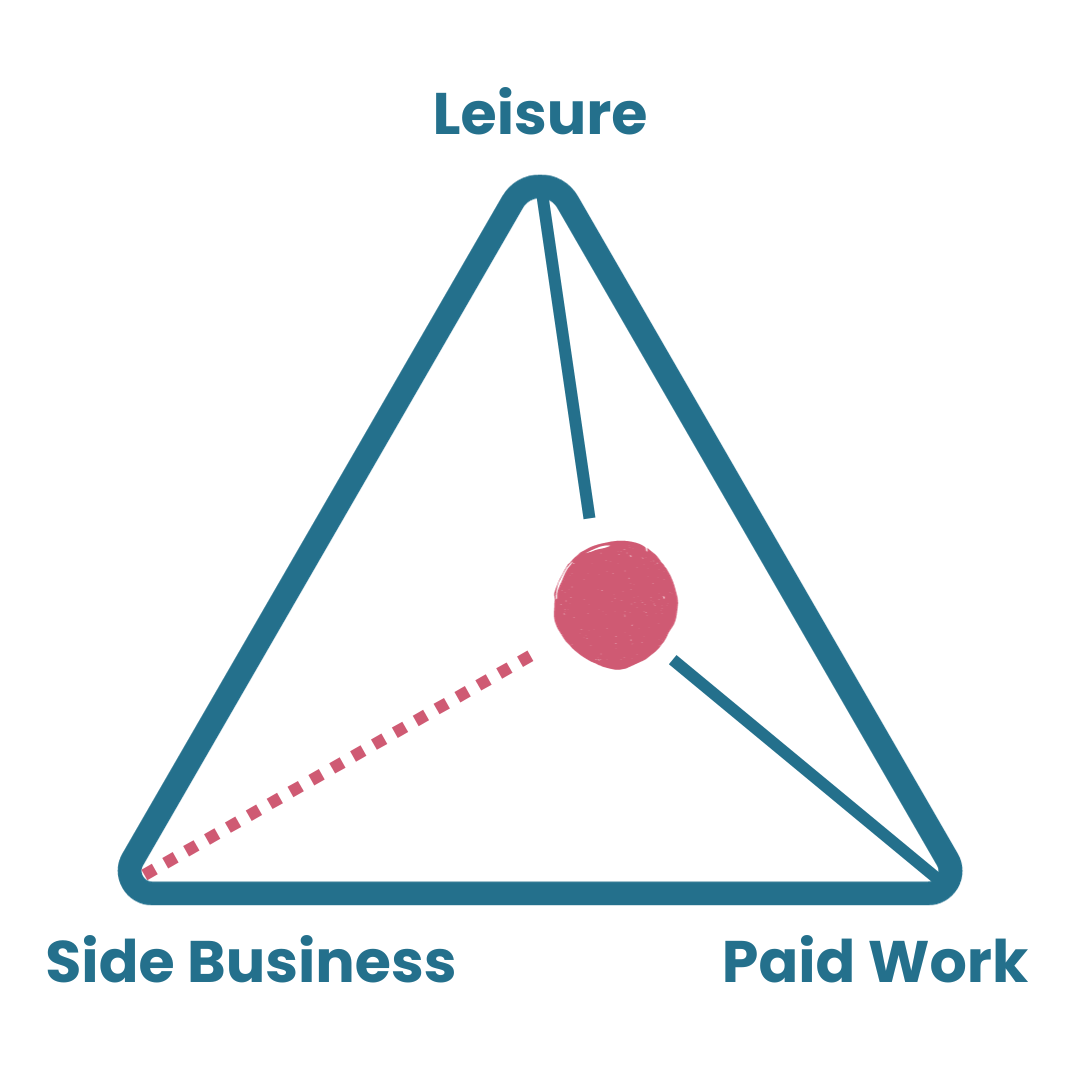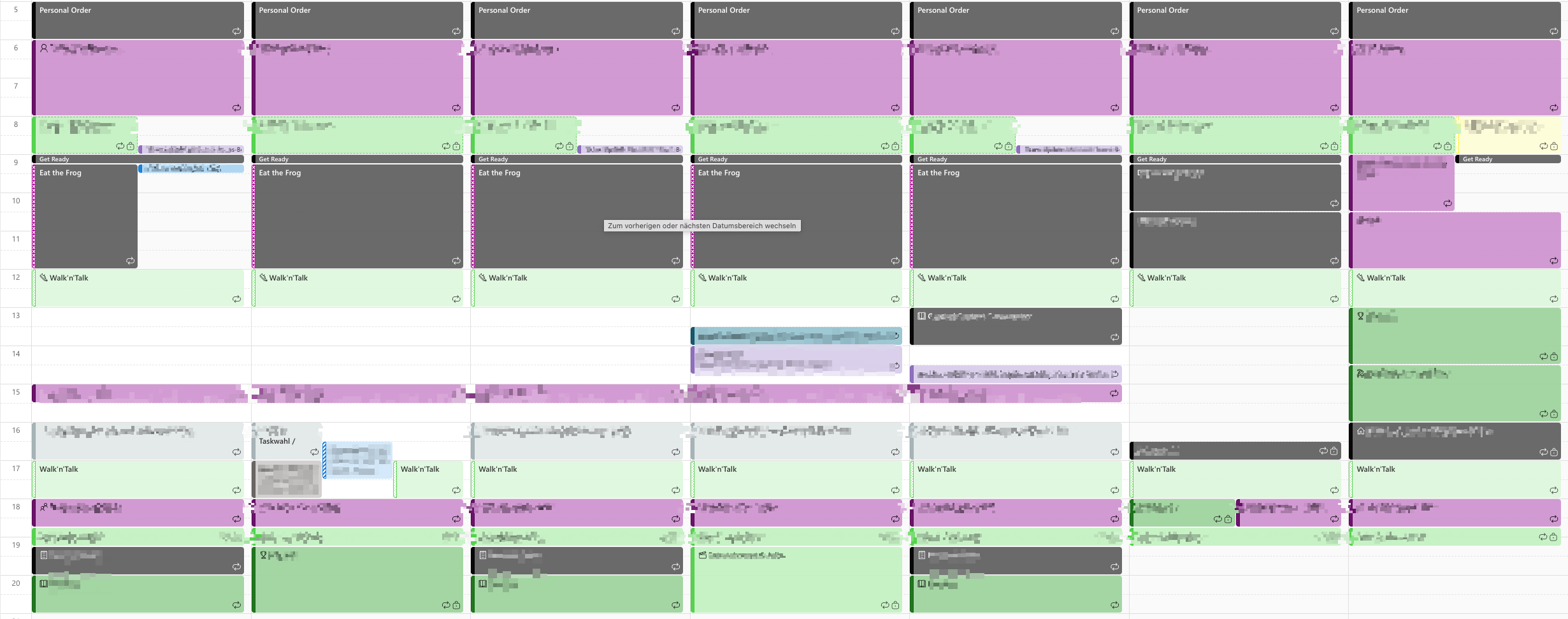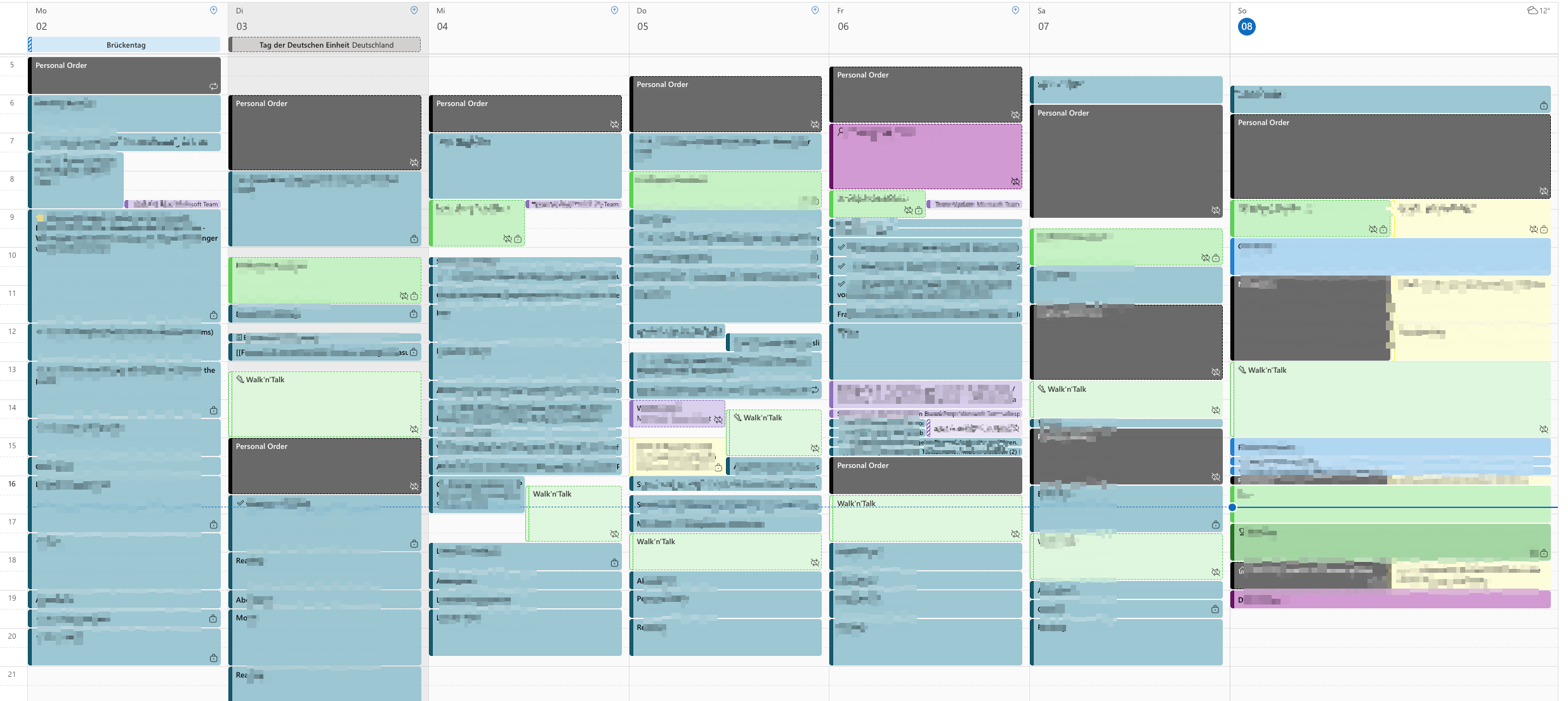Diligent Sunday #26: Plan your day with time blocks to fundamentally shift how you allocate your time.
Discover the benefits of Time Blocking in this newsletter. Learn how it enhances productivity, fosters work-life balance, and curbs procrastination. Includes practical steps to implement it effectively and insights from personal experience. Ideal for freelancers, consultants, and researchers.

Introduction
Hello everyone,
Another week has passed, and 76.8% of the year is already behind us. We're well into the year's fourth quarter, edging closer to its end.
I'm not sure about you, but for me, the onset of autumn is when I emerge from the busy hamster wheel of summer and find myself able to assess and, if necessary, correct my growth course.
Last weekend, my disappointment with my productivity peaked. Although recent months have been active and I've advanced in my main work, my side business, Deliberate Diligence, has stagnated. Time-consuming tasks like posting and networking on LinkedIn, my central discovery platform, left me little time to focus on creating my 3x3 Time Mastery Framework product. As a result, I failed (by far) to meet my July goal of launching my first online workshop and course.
In a visual triangle, I fell somewhat out of time management balance:

Balancing tasks isn't bad, but it isn't always needed, as the Magic Triangle theory suggests we can't equally focus on three things. A middle balance also isn't ideal because it could reduce the advantages of a single focus. Short sprints may be where you purposely accept imbalance to achieve significant progress.
For next quarter, I need to ramp up my side business efforts, which I'm willing to sacrifice leisure time for.
As the direction is set, applying these changes to daily life is challenging. Some can make time based on an abstract plan. For me, change comes slowly due to my reliance on habits. While instilling discipline and consistency, they also make it hard to change.
However, there is a method one can apply to get personal time allocation off autopilot mode and instead do it consciously.
This method is called Time Blocking.
The deal is to invest a bit more energy in your daily and weekly planning and, in return, gain more awareness and steering about using the most critical commodity in this world: the time personally available to you.
The big secret in life is that there is no secret. Whatever your goal, you can get there if you're willing to work." - Oprah Winfrey.

Definition: What is Time Blocking?
Time Blocking is a productivity method where you divide your day into blocks of time. Each block is dedicated to accomplishing a specific task or a group of tasks. This technique requires careful planning to maximise its effectiveness.
Time blocking is managing productivity based on time rather than tasks. Instead of working through a to-do list, you organise your day into segments, a method that allows more control over your time. This results in the efficient use of your available time, as tasks are fitted into pre-determined slots, which prevent distractions and increase focus.
Moreover, time blocking helps maintain work-life balance, as you manage not only your professional responsibilities but also personal ones. Defining how your time is spent in advance allows you to ensure that all aspects of your life get the attention they require, leading to a more balanced life overall.
"Productivity is never an accident. It is always the result of a commitment to excellence, intelligent planning, and focused effort." – Paul J. Meyer.

What are the considerations for Time Blocking?
Time Blocking, from my perspective, is a double-edged sword.
Advantages
On the one hand, it's fantastic for thoroughly allocating your time, distributing it across different life areas and underlying tasks.
- Want to lose 1kg per month? Then, allocate 40 minutes for endurance exercise (+20 minutes for preparation and wrap-up).
- Want to earn €1000 monthly from a side business? Then, ensure you can invest one hour daily into business operations and one hour into business and product development.
- Want to spend more focused, undisturbed time with your wife and children? Then ensure you have a single-focus time box from 6 pm - 8 pm in your calendar.
- And so on.
With this method, you can distribute the available 24 hours (minus eight hours for sleep) like a cake among the various parts of your life. This makes the importance and priority unmistakeable:
- You say family is important to you, but allocate only three-quarters of an hour for dinner? Then, in reality, it's not that important to you.
- You say you lead an active lifestyle but only have an hour's walk in your day. Sorry, that's not an active lifestyle.
- Do you want to become wealthy but invest zero time in yourself while spending eight hours on someone else's goals? Sorry to disappoint you, but you'll never be the one who truly benefits this way.
The explicit nature of this is wonderful. Both in terms of outlook, the plan, and retrospectively assessing what has happened. It offers clarity and serenity:
- Wondering how you should evaluate your week? Check if you wasted your time? Did you do "enough" for your priority? Look at last week's calendar; you'll see it in black and white.
- Are you concerned about whether you'll finish all your tasks this week? Each task has its place in your calendar. You can focus entirely on your current task and need not worry about the future.
- Asked to take on a task? Quickly looking at your calendar will tell you when you are realistically available.
- Do you have to urgently address an unexpected issue today that you hadn't anticipated? Time Blocking forces you to make rigorous decisions: Does the unexpected task replace a planned one? Can another task perhaps be abandoned?
- Want to schedule a meeting with a colleague? They can quickly check your calendar to see when you're free - it'll show both your existing meetings and personal work commitments.
Time Blocking necessitates real prioritization decisions like "If I do X, I can't do Y."
Not least, here are some more advantages that I do not want to withhold from you:
- Time Blocking helps focus – since every moment should have only one task, it allows you to disregard, at least for the moment, all thoughts of other topics or the future and concentrate exclusively on the task at hand.
- Accountability: Having a structured plan in front of you can be a powerful motivator. Knowing that you have allocated time for a task makes it more likely that you'll complete it.
- Enhanced Decision-Making: Visualizing your day minimises the cognitive load of deciding what to do next. This frees up mental energy for more complex decisions.
- Stress Reduction: Knowing each task has a designated time can reduce anxiety. You no longer have to keep a mental checklist of all the things you need to accomplish.
- Work-Life Balance: By intentionally setting aside time for relaxation and leisure, you can foster a healthier balance between work and personal life.
- Task Calibration: Time blocking enables you to evaluate how long specific tasks take, allowing you to make more realistic plans.
Disadvantages and Dangers
The advantages mentioned lead to the main disadvantage over time: after a while, you may feel significantly more productive, but emotionally, there is a sense of constant urgency. Each time block that ends is another mini-deadline closing in.
The urgency is good - it keeps procrastination at bay and ensures that time is used according to our (rational) intentions.
We are not purely rational beings but emotional ones. We need ample time to do nothing or at least nothing we perceive as useful. We need mental cool-down periods. Some forms of creativity need boredom to flourish (although problem-solving creativity will more often come on the spot with a deadline), and someone rigorously using Time Blocking would not experience boredom moments. There is always something to do. There is always time being used.
As you know, I greatly advocate leaving the busyness hamster wheel. Time Blocking is something that, if used incorrectly, can take you back on the hamster wheel if you unthinkingly pack all the tasks that come to mind into your calendar and work through them without reflection.
Other incorrect applications, from my point of view, are:
- Time Blocking as a constant state: If you maintain a rigid, non-stop schedule, you'll start to feel mechanical. Apply a balanced approach by alternating between structured, time-blocked days and free-flow days led by intuition. Think of time blocking as a tool, not a way of life.
- Dogmatic time blocking according to a textbook: It's a mistake to follow Time Blocking by the book. Customize what works best for you at present. Your Time Blocking plan isn't an absolute rule. Adapt based on needs.
So, one can navigate the potential risks and challenges with a mix of calmness and common sense.
"Sometimes the most productive thing you can do is relax." – Mark Black.

When can't you use Time Blocking?
You can use Time Blocking during your spare time, like mornings, evenings, and weekends.
Its application at work largely depends on your role. If you are a processor of tickets and business transactions, for example, a clerk or service manager, you must deal with the tasks as they come in. In such cases, Time Blocking doesn't make sense.
Time blocking is ideal for knowledge workers who have to convert goals into projects, milestones, and tasks and organize their efforts for effective plan execution.
Occupations Where Time Blocking Makes Sense
- Freelance Writers or Designers: Juggling multiple projects, deadlines, and client communications necessitates organised planning.
- Researchers: With various phases like literature review, data collection, and analysis, structured time use is crucial.
- Software Developers: They often work on multiple components of a project and can benefit from dedicated blocks of time for coding, debugging, and documentation.
- Consultants: Often handling multiple clients and projects, consultants can allocate specific time blocks for each responsibility.
- Academics: Professors or lecturers have varied tasks like teaching, research, and administrative duties, making time blocking a helpful tool.
Occupations Where Time Blocking Might Not Make Sense
- Emergency Room Physicians: Their work is highly unpredictable and time-sensitive, making time-blocking impractical.
- Customer Service Representatives: They need to handle issues as they come in, making it difficult to predict when they will be available.
- Restaurant Staff: With varying rushes and downtimes, pre-planned blocks of time may be ineffective.
- News Reporters: Due to the spontaneous nature of news, rigidly structured days could hinder their ability to report effectively.
- Retail Employees: Tasks can be highly variable and dependent on customer flow, making a fixed schedule difficult to maintain.
"Every job from the heart is, ultimately, of equal value. The nurse injects the syringe; the writer slides the pen; the farmer plows the dirt; the comedian draws the laughter. Monetary income is the perfect deceiver of a man's true worth." - Criss Jami.

How to Set Up Time Blocking?
Setup
When deciding to block time on a Monday, begin by setting it up on Sunday. First, list the tasks you anticipate performing the next day. Divide these tasks into time blocks in your schedule, trying to keep tasks requiring similar types of work or energy levels together.
Secondly, estimate the time you think each task will take and assign each a specific block in your schedule accordingly. Adding extra buffer time blocks to your schedule is also a good idea, so you aren't caught off guard by tasks taking longer than expected.
Finally, review your set tasks and time blocks to ensure they make sense and are realistic. Adjustments can be made to suit your needs better; the aim is to set a clear focus to achieve productivity and beneficial time management.
During the Day
In the morning, familiarise yourself with your set schedule, reminding yourself of the tasks ahead. Start performing these tasks, sticking to the planned time blocks, and avoid overrunning to ensure everything is completed according to schedule.
Throughout the day, keep referring to your time blocks, staying mindful of time spent on each task. If an unexpected task arises, try to fit it into your schedule without disrupting your previously charted tasks.
In the evening, assess your progress, noting the tasks you could complete according to schedule and those you weren't. Also, consider any disturbances or obstacles that were encountered during the day. Use this evaluation to improve the next day's schedule and to gain a better understanding of your individual work process and rhythm.
Weekly Reviews
At the end of the week, perform an overall review of the times blocked tasks. Evaluate how effective your task allotment and allocation were in promoting productivity. Also, assess whether the estimated timings were realistic and adequately accounted for the effort and energy each task required.
Then, use your evaluations and learnings to plan the subsequent week's schedule. Amend your task list, add and discard tasks as needed, and modify your time-blocking system to reflect your work style better.
"In preparing for battle I have always found that plans are useless, but planning is indispensable." - Dwight Eisenhower.

Personal Experience: My First Week
I've attempted time-blocking before, but it wasn't successful. Now, it's working great. I'm reaping the benefits and feeling more relaxed due to the sense of order it brings. Prioritizing tasks has become effortless, and last week, even when tasks took longer than estimated, I found innovative ways to finish other tasks quicker, such as by delegating or discarding tasks.
The most significant advantage is my reduced tendency to procrastinate. I usually delay critical but non-urgent tasks, which is quite daunting. But every task had a designated time last week, finally enabling me to tackle them all.

Overall, time-blocking is impressing me. Yes, I spend more time planning, ranging from 30-60 minutes daily, but the benefits far outweigh the extra work.
This is precisely how I approached the process:
- Last week, my dissatisfaction with my progress formed the basis for my starting (= motivation, purpose).
- I then tidied up my task list and discarded everything I no longer considered relevant.
- I also proactively considered things in my various life areas not listed on the task list but were still important (=brainstorming new tasks).
- I briefly deliberated on what tool to use. I had two calendars to choose from: Google Calendar (private) and Outlook (work). Despite preferring the privacy of my private calendar, I chose my work calendar as it contained all my work meetings, which my task time blocks had to flow around.
- The only disadvantage of this decision is that I can't easily integrate my work calendar into other apps, as it has been deactivated by the administrator of my company (data security). But using the Outlook web interface for time blocking also works incredibly well.
- Next, I changed the time grid in Outlook from 30 minutes to 15 minutes. This makes time blocks easy to customise by dragging and dropping, and the shortest time unit is 15 minutes instead of 30, as with the Outlook default. (P.S.: It could even be set to 10, 5 or 6 minutes, but that would be too granular for my preference.)
- First, I added routines to my calendar. Morning sessions run from 5 am to 8 a.m., followed by strength training until 9 am. Lunchtime and evening walks occur from 12 pm-1 pm and 5 pm-6 pm, respectively. My day ends with a reading session from 8 pm-9 pm.
- Routines structure my typical day, showing how much time is scheduled vs. free - surprisingly, free time is quite limited. I have three open blocks for allocation: morning (9 am-12 pm), afternoon (1 pm-5 pm), and evening (7 pm-8 pm).
- I categorized my free time based on energy levels. Mornings are for tackling harder tasks, thanks to my high energy. Afternoons, with moderate energy, are ideal for meetings and usual tasks. By 7 pm, my energy dips, with only leisure and fun planned.
- I reviewed my tasks, scheduled them on my calendar, considering energy levels and buffers, and then discarded the task list as it was no longer needed.
- I've colour-coded my calendar: dark green for leisure, light green for sports, purple for side work, and black for routines. Grey symbolizes spare time, red indicates importance, yellow works as reminders, blue represents tasks, turquoise shows completion, and orange denotes ongoing tasks. This system visually distinguishes between tasks and routines. It makes my calendar seem like a progress bar, which is motivational. And the orange colour shows unfinished tasks needing feedback or action.
- I start my morning by quickly reviewing the previous day in my diary. I consider the highs and lows, where I over or under-allocated time. I then adjust the current day's schedule, deciding on specifics. Questions like, "Should I walk or bike at lunch?", "How will I time-box my evening with my wife?", or "Do I want to tackle this morning's toughest task or switch it?" help shape my day.
- During the day, I kept my calendar open and set 15-minute timers. At the beginning of a task, I looked at how many 15-minute slots I had given myself for completion and kept it in mind during execution. The 15-minute intervals reminded me not to lose track of time and to be conscious of the 15-minute sessions. It's similar to the Pomodoro timer approach but with 15-minute sessions, and I take breaks as needed, not after every 15-minute session.
- I contemplated my options if I didn't complete a task within its time block. Do I delay its completion? Then, I'd schedule it for next week or an available buffer this week. Or is it urgent? I'd have to push back, drop, or condense a different task in that case.
- I marked a task as a time block on my calendar as completed (green) once I finished it, which gives a satisfying feeling. Not only ticking off the task but also seeing the weekly progress.
That's essentially it! One small thing I learned is to recognise new patterns in the day and improve them when planning the following week.
- For instance, I misjudged part of my morning routine by half an hour. I debated cutting tasks or extending time. I chose extra time to fix the structural scheduling flaw.
- While exercising, I often overlooked shower and prep time. So, I introduced a "Get Ready" routine, making my schedule more fitting.
All in all, I'm very satisfied with time blocking. I faced various day-to-day scenarios this past week, and the concept stood its ground.

However, I don't want to live it too dogmatically. For next week, I've planned to constantly ask myself in the morning how I want to shape the day: either time-blocked or in flow. This way, I can spontaneously decide how structured I want my day to be when necessary.
"Planning is bringing the future into the present so that you can do something about it now." - Alan Lakein.

The End
That’s all for this week! I hope I could inspire you to try time blocking. It's an unequivocal recommendation from my side; honestly brilliant.
In the meantime, I wish you a fantastic start to the coming 41st calendar week!
Best regards,
-- Martin (martin@deliberate-diligence.com)

Discussion